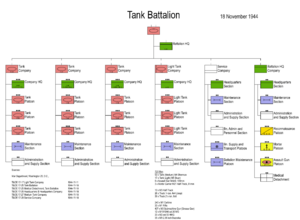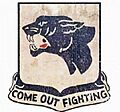761st Tank Battalion (United States) facts for kids
Quick facts for kids 761st Tank Battalion |
|
|---|---|
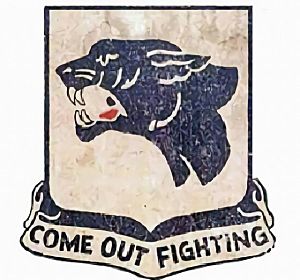 |
|
| Active | 1942–1946 (segregated unit) 1947–1955 (integrated unit) |
| Allegiance | United States |
| Branch | United States Army |
| Type | Separate tank battalion |
| Role | Armored warfare |
| Size | Battalion |
| Nickname(s) | Black Panthers |
| Motto(s) | Come Out Fighting |
| Colors | Blue, red, yellow |
| Mascot(s) | Black panther |
| Engagements | World War II
|
| Decorations | |
| Commanders | |
| Notable commanders |
Lt. Col. Paul L. Bates |
The 761st Tank Battalion was a special group of soldiers in the United States Army during World War II. This battalion was mostly made up of African-American soldiers. At that time, the U.S. military had rules that kept Black and white troops in separate units. The 761st was known as the Black Panthers because their unit symbol showed a black panther. Their motto was "Come out fighting."
The battalion earned a special award called the Presidential Unit Citation for their brave actions. Many individual soldiers also received medals. These included one Medal of Honor, 11 Silver Stars, and about 300 Purple Hearts. People have called the 761st "one of the most effective tank battalions in World War II."
Contents
Getting Ready for Combat
Before and during World War II, some U.S. military leaders were unsure about using African-American soldiers in battles. However, General Lesley J. McNair argued that these units should fight. Because of his idea, the U.S. Army started trying out separate combat units in 1941.
The 761st Battalion was officially formed on March 15, 1942. It started training on April 1, 1942, at Camp Claiborne, Louisiana. The soldiers began their training using M5 Stuart light tanks.
Most of the Black tankers trained in Southern states like Kentucky, Louisiana, and Texas. In those days, before the Civil Rights Movement of the 1960s, Black people were often treated unfairly. The men of the 761st trained for almost two years. They knew that white units were being sent overseas much sooner.
Jackie Robinson and Fairness
The most famous person in the 761st was First Lieutenant Jack Roosevelt “Jackie” Robinson. While the 761st was training, a bus driver told Robinson to move to the back of the bus. Robinson refused. He was then arrested.
The battalion commander, Lieutenant Colonel Paul L. Bates, did not agree with the charges against Robinson. So, the base commander moved Robinson to another unit, the 758th Tank Battalion. That unit's commander was willing to sign the order for a military trial. Robinson was found innocent of all charges. After the war, he became famous for helping to end segregation in professional baseball.
Going to War
General Ben Lear said the 761st unit was "superior" after a special review. He decided they were ready for battle. After a short time in England, the 761st landed in France on October 10, 1944. They arrived at Omaha Beach.
The unit had six white officers, thirty Black officers, and 676 Black enlisted men. They were assigned to General George S. Patton's US Third Army. General Patton had asked for them. They joined the 26th Infantry Division.
The 761st fought in Northern France starting in October 1944. They were part of the famous Battle of the Bulge. Later, they moved into the Rhineland area. They spent the last months of the war fighting on German soil.
Fighting in Europe
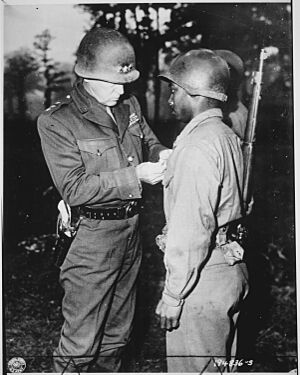
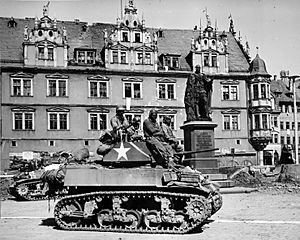
The battalion first saw combat on November 7, 1944. They fought through towns like Moyenvic and Vic-sur-Seille. Often, they were at the very front of the advance. The fighting at Morville-lès-Vic was especially tough. The unit was in continuous action for 183 days.
In November 1944, the 761st Tank Battalion had 156 soldiers injured or killed. They also lost 14 tanks and had 20 others damaged. In December, the battalion quickly moved to help the 101st Airborne Division at Bastogne.
To help push the Germans away from Bastogne, the battalion fought to capture the city of Tillet. This city was less than 15 kilometers west of Bastogne. In early January 1945, with only 11 tanks, the battalion took control of Tillet. They fought the 113th Panzer Brigade for two days, losing 9 tanks in the process.
After the Battle of the Bulge, the unit helped the U.S. 4th Armored Division enter Germany. They broke through the Siegfried Line, a strong German defense. The 761st then moved quickly through Germany, smashing through many German cities and towns.
In the final days of the war in Europe, the 761st was one of the first American units to reach Steyr, Austria. They met the Soviet Red Army at the Enns River. On May 4, 1945, the 761st and the 71st Infantry Division freed the Gunskirchen concentration camp. The German guards had left shortly before they arrived.
The 761st was officially stopped on June 1, 1946, in Germany. They are remembered as "one of the most effective tank battalions in World War II." Overall, the battalion earned about 300 Purple Hearts.
Ruben Rivers' Medal of Honor
Staff Sergeant Ruben Rivers was awarded the Medal of Honor in 1997. This award was given to him after his death for his amazing bravery. He served with Company A of the 761st.
His official award description says: "For extraordinary heroism in action during the 15–19 November 1944, toward Guebling, France. Though severely wounded in the leg, Sergeant Rivers refused medical treatment and evacuation. He took command of another tank and advanced with his company in Guebling the next day. Repeatedly refusing to leave, Sergeant Rivers kept directing his tank's fire at enemy positions. This continued through the morning of November 19, 1944. At dawn, Company A's tanks began to advance towards Bourgaltroff, but enemy fire stopped them. Sergeant Rivers, joined by another tank, fired on the enemy tanks. He covered Company A as they pulled back. While doing so, Sergeant River's tank was hit. This killed him and wounded his crew. Staff Sergeant Rivers' fighting spirit and daring leadership inspired his unit. They show the highest traditions of military service."
"Baddest Man in the 761st"
Sergeant Warren G. H. Crecy was a tank commander. On November 10, 1944, he helped his men by fighting through enemy positions. His tank was destroyed, but he didn't stop. He took another vehicle armed only with a .30-caliber machine gun. He then destroyed the enemy position that had knocked out his tank. He also killed German observers who were directing artillery fire on the U.S. positions.
Later, Crecy got a replacement tank. This new tank got stuck in heavy mud. He had to get out of the tank under heavy machine gun, antitank, and artillery fire to free it. When German soldiers attacked, he had to stop trying to free the tank. He used the tank's .50-caliber machine gun. He stopped the attacking enemy and made them retreat.
Crecy was described as a "quiet, easy-going, meek-looking fellow." But he destroyed an antitank position and many German machine gun positions. He did this with only a machine gun and without caring about his own safety, all under heavy fire. His men reportedly had trouble getting the machine gun away from him after the fight.
Crecy was put forward for the Medal of Honor. He also received a promotion on the battlefield. He eventually retired as a major. His brave actions earned him the nickname "Baddest Man in the 761st" from his fellow soldiers.
After World War II
When African-American soldiers returned home, they often did not receive the same warm welcome as white units. This unfair treatment was very disappointing. However, the excellent service of many Black combat units helped convince the government to end segregation in the U.S. Armed Forces. This happened soon after the war, under President Harry S. Truman.
On November 24, 1947, the 761st was brought back into service. This time, it was an integrated unit, meaning Black and white soldiers served together. It was assigned to the Regular Army. The unit served until March 15, 1955, when it was stopped again.
Permanent Monument
A monument honoring the 761st Tank Battalion was revealed on November 10, 2005. This happened at Fort Hood, Texas. Surviving veterans attended the ceremony. It is a lasting tribute to the soldiers who served for freedom, honor, and democracy.
The monument has four black granite tablets. These surround a life-size marble statue of a 761st Tank Battalion soldier. The soldier is kneeling on a black granite stand. This stand has a tank carved on the front and a panther on the back. The monument is located on 761st Tank Battalion Drive.
Awards and Recognition
The 761st Tank Battalion earned many awards for their service:
- Campaign Streamers: Northern France, Rhineland, Ardennes-Alsace, Central Europe.
- Presidential Unit Citation
- Medal of Honor: 1
- Purple Hearts: 296 (8 with clusters)
- Silver Stars: 11
- Bronze Stars: 69
They fought in many countries, including France, Belgium, the Netherlands, Luxembourg, Germany, and Austria.
Images for kids


